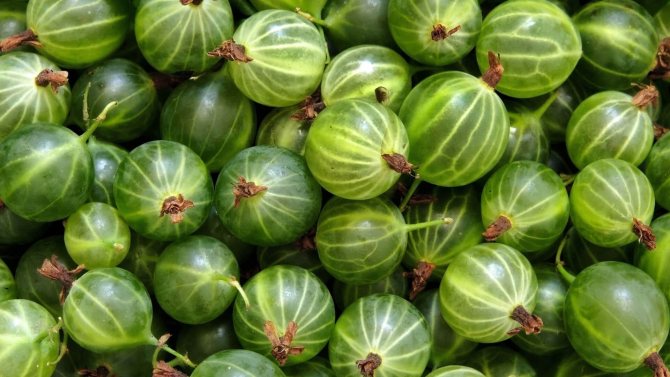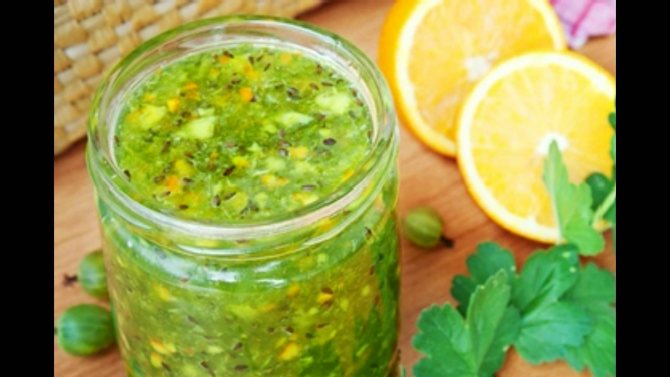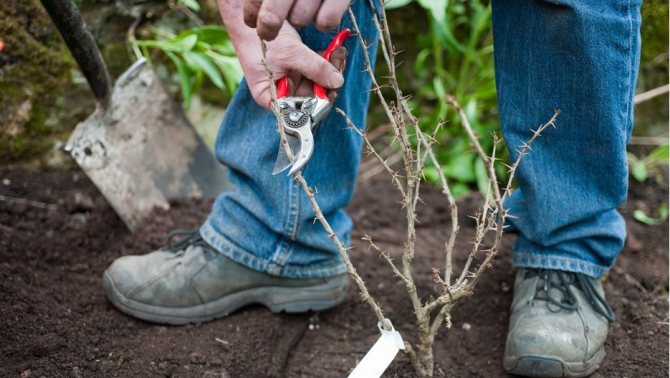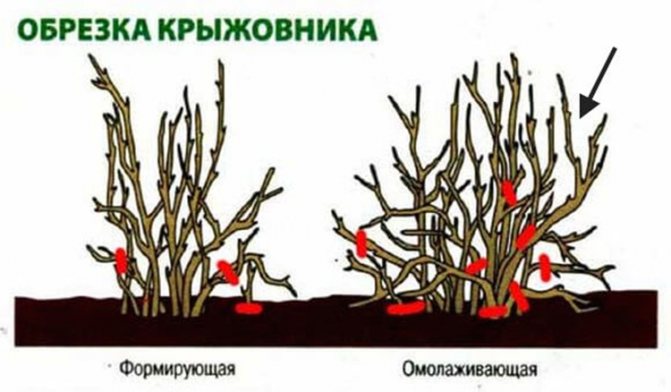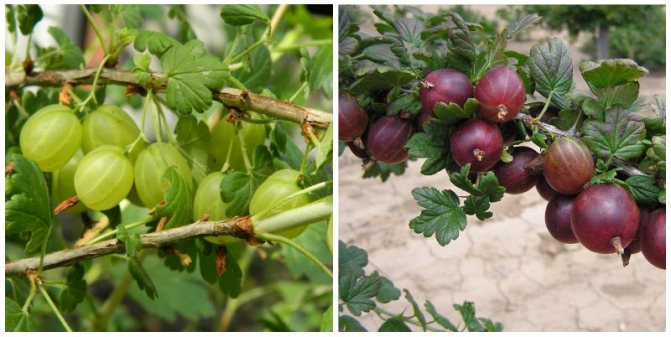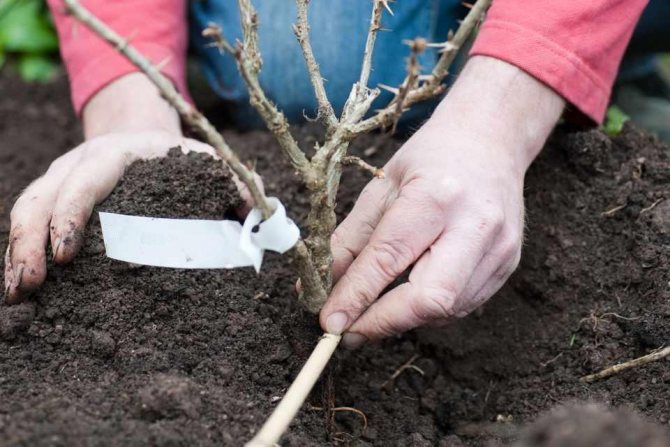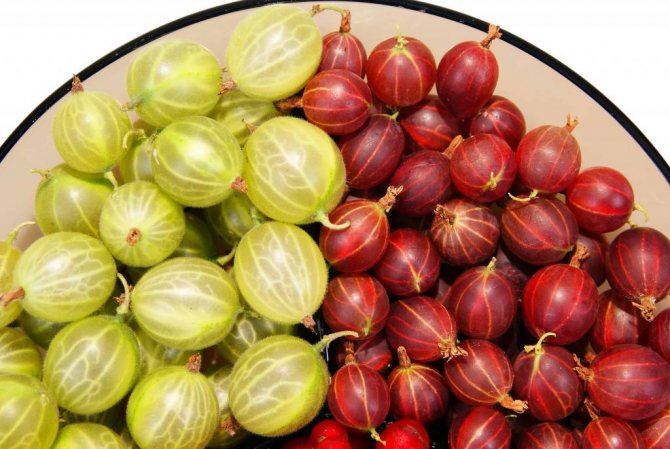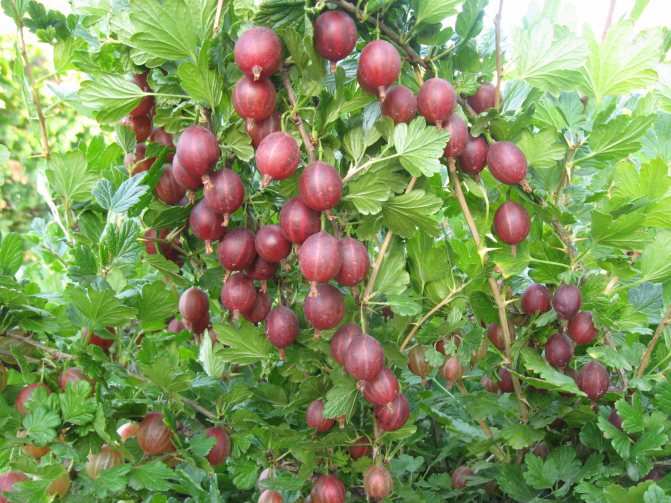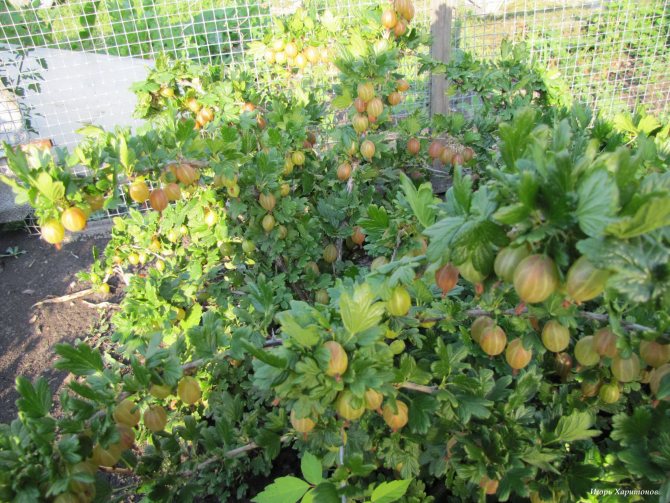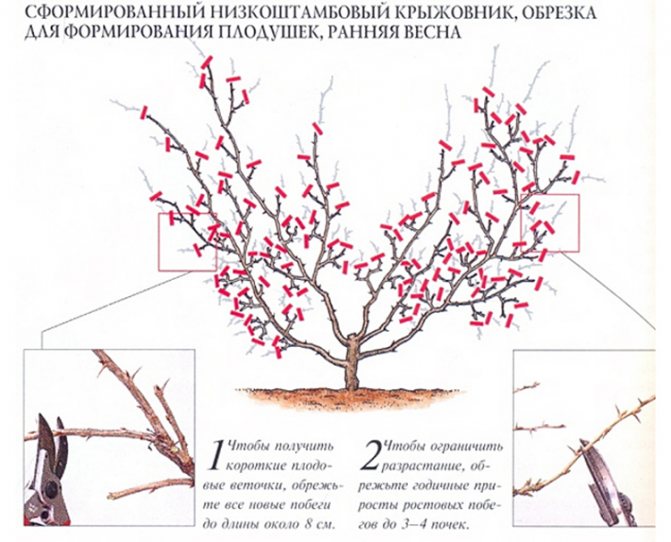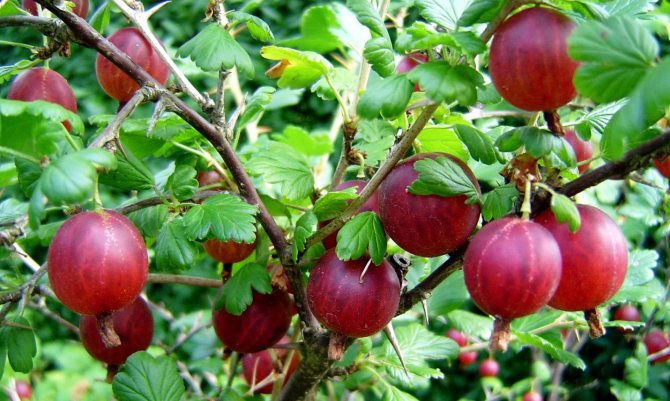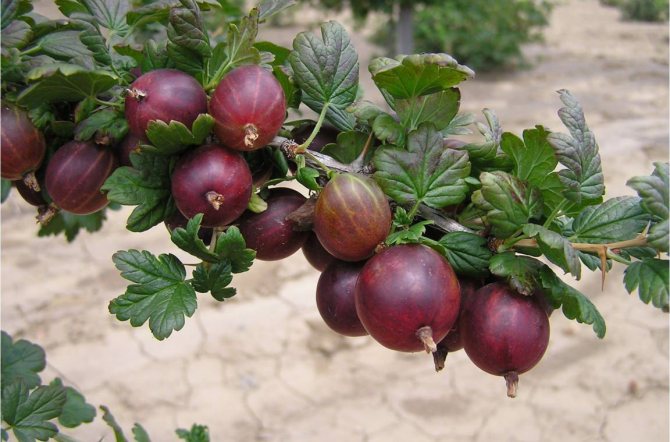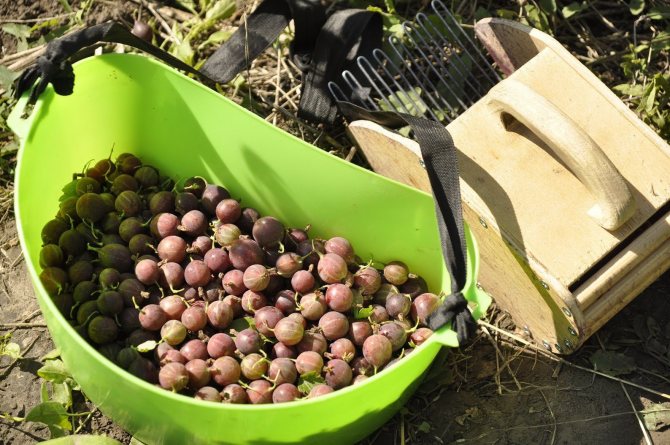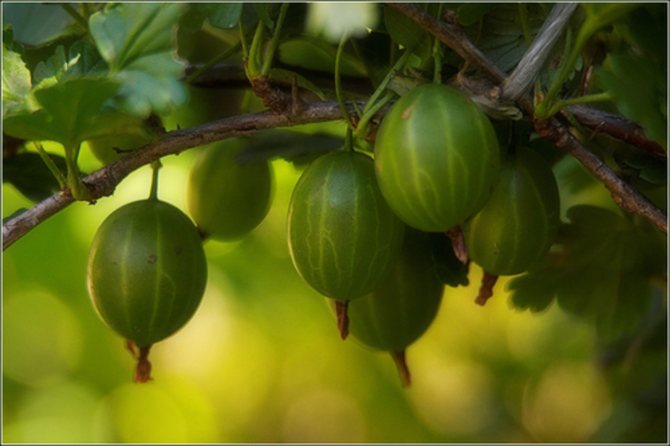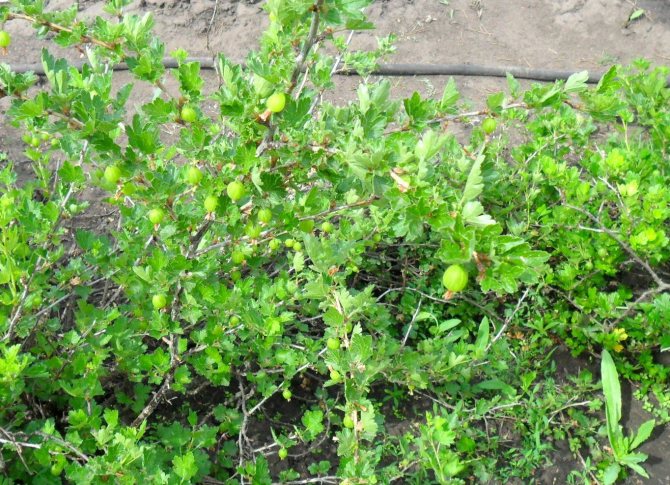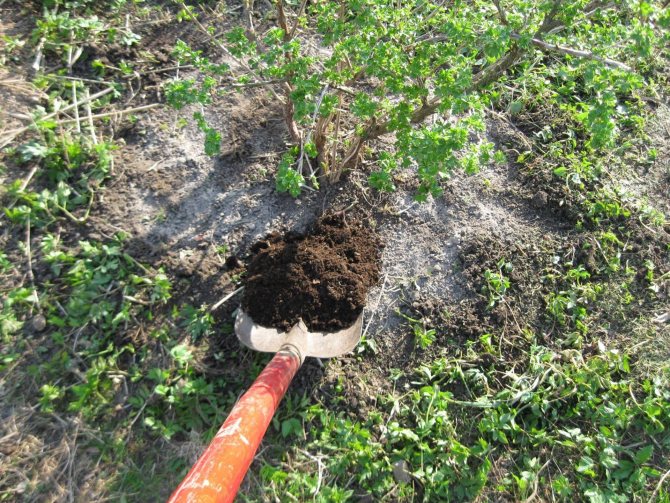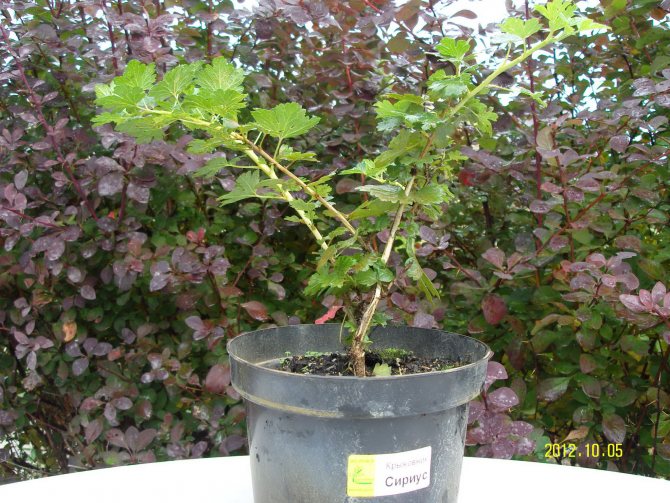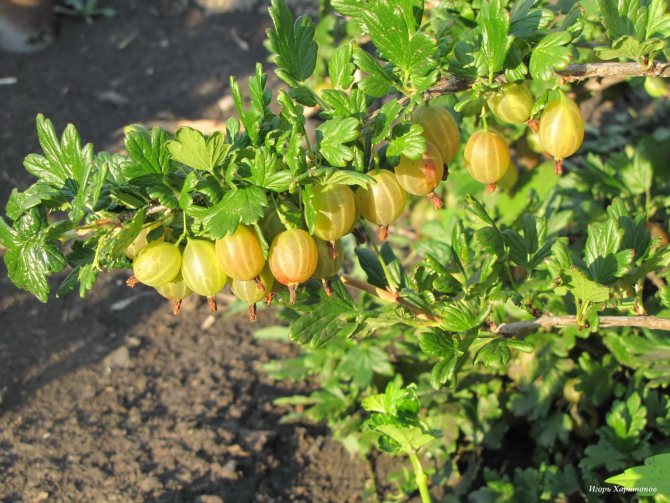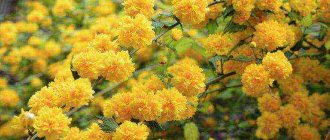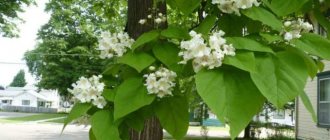Gooseberries, planting and caring for which will be discussed in this article, belongs to the genus of currants and appeared in North Africa, as well as in Western Europe. In the wild, this plant can also be found in the Caucasus and North America. The gooseberry was first described by Ruel in 1536. And breeders from America managed to develop varieties that are not affected by powdery mildew.
Today this crop is grown in almost all countries of the world. Further, it will be considered what kind of gooseberry is, planting and care in the open field, as well as pests and diseases of this plant, measures to combat ailments and their prevention.
Description of bushes
The gooseberry grows as a bush. Its height can reach one hundred and twenty centimeters. The bark of the plant is gray-brown in color and has thorns, the origin of which is leaf. And on cylindrical young shoots, thin thorns can be found. There is also a thornless gooseberry, planting and caring for which will be discussed in more detail below. The leaves of the plant reach a length of six centimeters and are round in shape. Flowers bloom in May and are reddish or greenish. Fruits are oval, smooth or covered with fine bristles. Usually their size reaches twelve millimeters, but there are specimens in which the berries grow up to forty millimeters.

Fruit ripening occurs in July or August. They can be green, yellow, red and even white in color. Berries are very healthy because they contain organic acids and salts of many metals. Gooseberry is a self-fertile crop. This means that even one bush in the garden will regularly bear fruit over the years.
Choosing seedlings
Many horticultural markets and specialty nurseries offer gardeners a variety of gooseberry seedlings.
When purchasing bushes in a nursery, you need to make sure of their quality and in full compliance with the variety.
When choosing a seedling, you need to pay attention to the root system. The neck must be intact, no damage is allowed, and the roots must be healthy. Do not pay attention to the size of the shoots of the bush. The main thing is to have a good root system. It will allow the plant to quickly take root in a new place with a subsequent increase in the size of the bush itself.
Gooseberry varieties
Depending on what kind of gooseberry you grow, planting and care, reproduction and treatment of plants may differ. All varieties of the bush can be divided into two large groups. The first includes European representatives. This group is distinguished by a longer productive period and large berries. But it is more susceptible to attacks by various pests and diseases. The second group is hybrid varieties, or in other words, American-European. Representatives are much more resistant to various ailments. Gooseberry varieties may differ from each other even in the arrangement of thorns or their absence. The thornless species include eaglet, serenade, and tender.
Often in gardens you can find a hybrid plant that combines currants and gooseberries. Planting and caring for him is similar to other members of this genus.The name of this hybrid is Yoshta. And he also enjoys considerable popularity.
How to prepare bushes for winter and how to fertilize?
As a rule, adult berry growers tolerate winter well. Young, weakened plants, representatives of heat-loving varieties and gooseberries, "living" in cold climatic zones, need help.


After carrying out all the autumn planting work, the planting should be mulched: cover the surface of the earth under the bushes and in the aisles with a 10-centimeter layer of natural protective material - rotted manure, ripened humus, peat, sawdust, small branches. In winter, warmth is kept under such a litter, and organic processes continue.
In areas of severe winter (in the North in Siberia, in the Urals), as well as in gardens with southern varieties and cold winters with little snow, gooseberry branches are neatly bent to the ground, fixed with flyers or planks. From above, they are covered with pine or fir spruce branches, additionally covered with snow. The needles not only trap snow, create an additional "fur coat", but also serve as an antiseptic, scaring off rodents and pests. A cover of snow will reliably cover and protect from the cold.
For additional snow retention and protection from cold winds, hedges and barriers are created.
Gooseberry is a popular, high-yielding and highly responsive crop. It is not that difficult to grow her. The factors of a bountiful harvest are correctly selected zoned varieties resistant to damage, their varied assortment in the garden, competent year-round care. Timely and correctly carried out work will save the efforts of the gardener and extend the life of the berry shrub.
The garden long-liver - gooseberry - will delight lovers of delicious berries for decades.
Tags: gooseberry, autumn, after, collection, harvest, care
About
«Previous post
When to plant gooseberries
If you decide to breed gooseberries on the site, planting and caring in the open field will require some knowledge and skills from you. You can plant a bush either in spring or in autumn, but only from late September to mid-October.
It is necessary to choose the right place for the plant, since its root system is quite long, gooseberries should not be planted in the lowlands. So you increase the risk of infection with fungal diseases. It is best to find a sufficiently lit place on a plain or hillock. Try to choose an area that is sheltered from the wind. Good results can be obtained by planting shrubs in sandy or clayey soil. It is only important not to forget that such soil requires frequent loosening.
There is one more thing to consider when choosing when to plant gooseberries. Planting and leaving in spring is not much different from autumn activities. Experienced gardeners are advised to choose the autumn time for planting. This is due to the fact that the bushes planted in October have much better growth and survival of the shoots.
Gardener mistakes
The wrong actions of the gardener can lead to a poor harvest. So, beginners often make the following mistakes:
- Preparing the soil for winter, they dig the soil around the bush too deeply, as a result of which the root system of the plant is damaged. It is categorically impossible to loosen the soil deeply within the radius of the roots.
- Bushes are unnecessarily pruned or this garden manipulation is completely neglected, as a result of which fruiting and the normal development of the plant are disrupted. Autumn pruning should be carried out every year, but strictly in compliance with the previously given rules.
Gooseberry is one of the main "long-livers" of vegetable gardens and home gardens. If you carry out the autumn work and the appropriate processing of the crop correctly, then every season you can harvest a large harvest of any berries. It is noteworthy that with proper care, one course can bear fruit for one and a half decades.
0
Planting gooseberries in autumn
If you have decided what time of year to plant gooseberries (planting and leaving in the fall is more preferable), then we can move on to the theoretical part of this question.
Weeding the soil around the gooseberry bush is very inconvenient: all because of the large number of thorns. Therefore, the site is cleared of weeds in early autumn. For this, the area where the bushes are supposed to be planted is dug up. During this process, it is necessary to remove all weed roots from the soil with special care.
The next step after cleaning is preparation. The soil surface is leveled with a rake. All earth lumps break well. Two weeks before planting the plants, cube-shaped holes are dug. Each face should be half a meter. This is done in advance so that the land settles before planting the bushes. The fertile soil layer, which is located at the very beginning, is removed and mixed with fertilizer. If the soil is clay type, then you need to add a bucket of river sand to the mixture.
Between two adjacent bushes, a distance of one to one and a half meters should be observed. But the distance between the rows of bushes should be at least three meters.
Choose one year old or two year old seedlings. Their root system is well developed and is about thirty centimeters long. The ground part of the plant should be formed by several strong shoots. Soak the roots in a fertilizer solution for twenty-four hours before planting. Prepare it by adding three or four tablespoons of nutrients to five liters of water.
It is necessary to place the seedling in the hole straight, giving it a slight slope. The roots are carefully and carefully straightened, making sure that the root collar is slightly below the soil level. The earth is covered in portions: each part is well compacted.
For one bush, a bucket of water is used for irrigation. After the soil is saturated with moisture, mulching is performed. For this, peat or humus is used. Then the shoots are cut, leaving five or six buds on each segment.
In order for you to eventually grow a beautiful, healthy, and most importantly - well-fruiting gooseberry, planting and care must be carried out in accordance with all the rules.
Other recommendations
Autumn is a good time for plant propagation. If new seedlings are required by the spring, since August they bend down the strongest branch itself, fix it, sprinkle it with soil. Then the branch is watered, mulched with grass in order to keep the earth moist for longer.
In climatic zones where frosts in winter reach -35 ... -40 degrees, it is recommended to warm the gooseberry, because its young roots slightly go deep into the soil.
Warming is carried out before the first snow falls in this way:
- spud the bush, making a mound 20 cm high;
- form a thick layer of earth;
- put peat, humus, pieces of bark on top.
You can also cover the plant in the same way as roses. The branches are tied, bent down, and thrown over with spruce branches, hay, leaves. After the gooseberry is tied with a covering material (agrospan). The insulation must be removed in the spring as the warming progresses.
Correct implementation of all actions will help to preserve the plant even after a harsh winter and increase the yield!
Spring care
When nature awakens from winter sleep, gooseberries also require some care. Planting and caring for this crop in the garden is not difficult for either experienced gardeners or beginners. The main thing is to comply with all agrotechnical rules. As soon as spring has come, before the snow has even melted, it is necessary to spray the gooseberry bushes with boiling water through a spray bottle. They do this in order to prevent damage to plants by pests and diseases.
In early May, you need to loosen the soil around each bush, deepening ten centimeters, and then mulch the soil. At the same time, feeding is done.
Gooseberry is one of those plants that are too acutely experiencing a lack of moisture in spring and summer. The best irrigation method is subsoil or drip. It is these options that make it possible to transport moisture directly to the root system, which is located at a depth of five to forty centimeters. Thus, the gooseberry is watered about five times during the growing season. Watering the plant with the upper method with cold water is not permissible.
If you decide to arrange gooseberries in rows in your garden, planting and caring in a set of activities will require the support of low hanging branches. To do this, at a height of about thirty centimeters, stretch marks are pulled between the rows or nets are used.
Raspberries after harvest
Watering raspberries
Raspberry care involves regular watering of the bush, since drying out of the soil in the raspberry tree is unacceptable. If the autumn is dry, it is necessary to water the raspberries, especially since their roots do not lie deeper than 25-35 cm. The soil in the area where raspberries grow should be slightly damp all the time. If the plot is mulched and if it is autumn with rains, you will need to water the raspberries less often.
Feeding raspberries
Raspberries are the most demanding of all berry bushes in terms of nutrition, since the raspberry yield directly depends on the thickness of its stems: the thicker the stem, the more berries it will have next year. Fertilizers applied to the soil stimulate the growth of shoots. Based on this, the cultivation of raspberries involves regular feeding. The best fertilizer for raspberries is organic matter: slurry, bird droppings, peat compost.
Even if during planting you put a large amount of fertilizer in the pits, they will only last for three years, and starting from the fourth, you need to regularly apply organic fertilizing in the fall. As Academician Bolotov once said, raspberries bear fruit well in places “where the leg drowns in manure,” therefore, as soon as the fruiting of raspberries is complete, nitroammofoska is scattered around the site for digging row spacing at the rate of 50-80 g / m², and in the fall under each bush make 3-4 buckets of peat or humus and 100 g of saltpeter or urea.
Raspberry pruning
Post-harvest raspberry care includes pruning the shrub in the fall. As you know, raspberry stalks bear fruit only for a year, and it is unwise to leave the stalks that have yielded harvest for the winter, therefore, in the fall, such shoots are cut as close to the ground as possible so that there are no stumps left in which pests or pathogenic fungi can settle.
Do not allow the bushes to grow together with each other, immediately cut off the small root shoots around them - there should be a distance of at least 60 cm between the raspberry bushes.And keep in mind that the cut stems and parts of the shoots must be burned.
Reproduction of raspberries
In autumn, after the end of the growth of shoots, if necessary, you can propagate raspberries by dividing the bush. The bush is dug up, divided into parts with well-developed roots and planted. After transplanting, raspberry shoots are shortened to 20-30 cm. The best time to divide the bush is mid-October. If in the summer you did not cut off the green root shoots, then by the fall you had a sufficient number of root suckers on your site with an independent root system, but still connected to the mother plant. Dig up these children with an earthen clod and transplant to a new place, cleared of other plants and weeds.
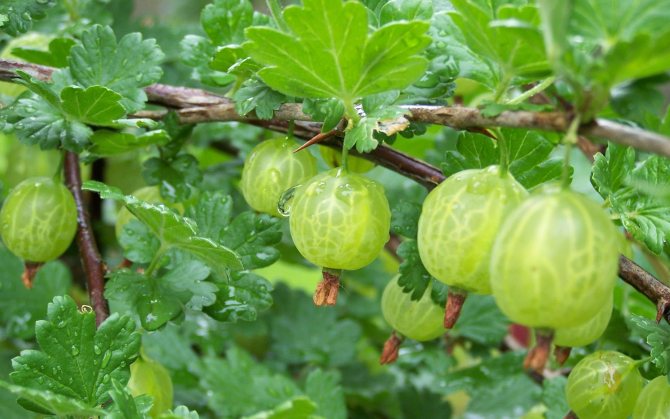

In the fall, after the first light frosts, it is time to harvest lignified cuttings, which you will root at home in winter, and plant them on the site in spring.
Raspberry processing
Diseases and pests of raspberries, if you do not fight them mercilessly, can destroy the entire raspberry tree in a year or two. That is why it is so important to carry out preventive treatments of the bushes, and not wait until diseases or parasites begin to destroy the fruits of your labor. As soon as the last berries are collected from the bushes, treat the shrub with a fufanon solution - 10 ml of the drug per 10 liters of water.Consumption of solution for one bush is approximately 1-1.5 liters.
Instead of fufanon, you can use actellic by diluting one ampoule of the product in two liters of water. Actellik consumption - 1.5 liters of solution per 10 m². Inta-vir also belongs to such means, the tablet of which is dissolved in 10 liters of water and the solution is consumed like actellic. In the fall, after the area has been cleared of fallen leaves and plant cuttings, process the raspberries and soil under the bushes with one percent Bordeaux liquid.
Reparability - the ability to bear fruit continuously throughout the growing season. In addition, remontant raspberries bear fruit on both annual and two-year shoots, so, in principle, it is possible to get two harvests per year. Having taken off the harvest in August-September of this year from annual stems, in the twentieth of June next year, you can get a harvest from two-year-old shoots, but the berries of the next autumn harvest will be small, dry and bony, because the June harvest takes away all the strength from raspberries, which is barely enough for the growth of annual replacement shoots, but not enough for full-fledged re-fruiting.
Therefore, if you want to get two full-fledged crops per year, you will have to actively feed and water remontant raspberries, however, these measures do not guarantee the desired result. It is much easier and wiser to grow common raspberry varieties that bear fruit in early summer, and remontant varieties for a full autumn harvest.
In this case, cut off the remontant raspberries in the fall, after fruiting, you need to completely, trying not to leave hemp. In the spring, the stems will grow back, and in late summer or early autumn they will give an excellent harvest of large juicy berries. Thus, you will have a remontant raspberry with a one-year growth and fruiting cycle.
But if you want to get two harvests a year, immediately after the first, summer fruiting, remove the two-year-old fruiting stems so that the raspberries have time and strength to grow the shoots of the current year by autumn, which will give the berries of the second, autumn harvest. And in time, remove too weak, thin branches so that they do not take away nutrition from the sturdier and more promising stems in terms of fruiting.
Sections: Fruit and berry plantsBerry bushes
We offer you to familiarize yourself with: Tomato Filippok: description of the variety, characteristics and care with a photo
After this article, they usually read
Top dressing of gooseberries
Since the fruits on the gooseberry ripen for many years, it also absorbs nutrients from the ground in huge quantities. This leads to the need for annual fertilization. Moreover, they must be of a mineral and organic nature. In order for a healthy and prolific gooseberry to grow on your site, planting and maintenance must certainly include nutrient introduction measures.
In the spring, the following mixture is prepared: superphosphate in the amount of fifty grams is added to half a bucket of humus, as well as ammonium sulfate and potassium sulfate. The last substances are twenty-five grams each. If the bush is very large and gives a bountiful harvest, then all components should be doubled.
Nutrients should be applied along the perimeter corresponding to the size of the crown. After fertilization, the soil is loosened. As soon as the gooseberry has faded and after another two weeks, the plant is fed with mullein solution. Mix one part of the mixture with five parts of water. Each bush should have at least five liters.
Main types of work
Early gooseberry varieties allow you to enjoy the first berries only in July. The main crop is harvested in late August and early September.
Immediately after the harvest, work is organized to care for the shrub.With the correct organization and conduct of events, you can be sure of a good harvest for the next year.
Leaving involves performing several actions:
- pruning, thinning;
- work with the soil (weeding, loosening, mulching);
- fertilizing with organic matter and mineral-based fertilizers;
- watering;
- treatment of bushes for prevention;
- treatment of bushes from diseases.
Gooseberries: planting and care, pruning. What year does it bear fruit
A gooseberry bush planted on the site begins to bear fruit after three years. The plant brings a crop for ten or even fifteen years.
The branching of the bush is strong enough, which does not contribute to a good harvest. This is why gooseberries should be pruned. This can be done in the spring or fall. In general, the bush should have ten shoots of different age categories.
Spring pruning is done before the buds swell. It is necessary to ruthlessly remove all shoots that, after wintering, turned out to be weakened, dry, diseased or broken.
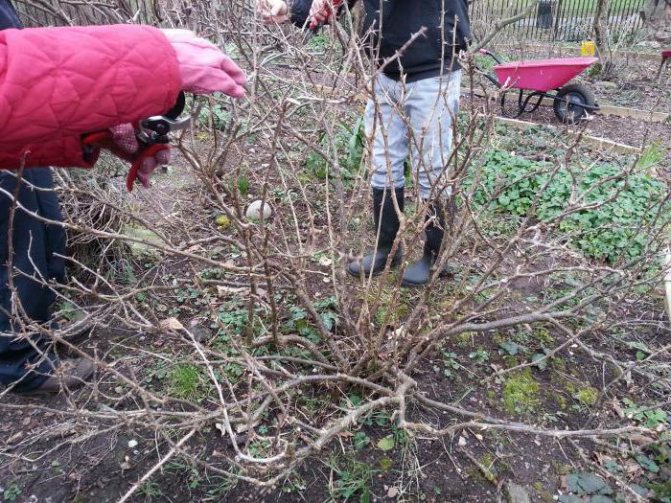

In addition to all the listed candidates for removal, it is necessary to trim the shoots near the roots and weakened ends of the branches. All this must be done before the plant awakens, and it happens very early. If you are late with pruning, you will do a lot of harm. Based on this, it becomes clear why experienced gardeners prefer to prune the bushes in the fall. This way you can less injure the gooseberry. Planting and maintenance (pruning) carried out in autumn allows the bushes to better adapt to winter and acquire frost resistance. And also practically negates possible damage.
Autumn pruning is performed annually. If this is not done, then by the third year the bushes thicken to such an extent that the fruits greatly lose their quality. Branches of five and seven years of age are the most valuable. Also branching of the first three orders. All others do not have good productivity. Shoots more than ten years old are black and removed to their very base. Also, do not forget that too long branches should also be shortened. After the pruning is completed, all cuts must be treated with garden varnish.
How to care for gooseberries after harvest in August and September
Late summer and fall lays the foundation for plant health and next season's harvest. You should start immediately after picking berries, and before the onset of frost you should have time:
- carry out a thorough weeding under the bushes, remove weeds, fallen leaves and other vegetation remnants;
- shed each plant abundantly;
- make top dressing;
- dig up the ground under the bushes and in the aisles,
- treat the shrub with means of protection against diseases and pests;
- cut off old and weakened branches;
- to mulch;
- prepare for overwintering.
We suggest you familiarize yourself with: Growing a rich crop of pepper
Soil cleaning
Immediately after removing the fruits, the gooseberries are carefully weeded, removing grass, weed roots, accumulated sticks, twigs and other debris from under it. Fallen leaves are immediately burned to avoid overwintering of pathogens in them.
About a month before the arrival of frost, it is important to carry out the so-called water-charging irrigation. Each bush will require at least 50 - 60 liters of water, you can pour it in two or three stages. The supply of liquid will allow the gooseberry to endure cold weather, resist diseases, and form fruit and vegetative buds.
Gooseberry care procedures: watering and mulching
Autumn feeding
At the end of the harvest, the gooseberries are fed with superphosphate (up to 50g) and potassium chloride (up to 30g). One liter of ash can be added as a potash fertilizer. Phosphate fertilizers increase yields. Potash plants provide drought resistance, frost resistance, increase immunity to fungal diseases.
In the fall, each bush is "fed" with organic fertilizers:
- humus - one bucket;
- chicken manure diluted in water (1 in 10) or mullein (1 in 5).


On acidic soils, additional lime, chalk or dolomite flour is required.
Reference. Fertilizer rates should be increased if the soil on the site is neutral or slightly alkaline.
Gooseberries: planting and care, propagation by cuttings
This culture, like all other plants, needs reproduction. We discussed earlier in the article in what conditions gooseberries should grow. Planting and caring, reproduction and planting - all this requires certain knowledge and skills. Reproduction by cuttings is considered the most time consuming option. And the result is not always positive.
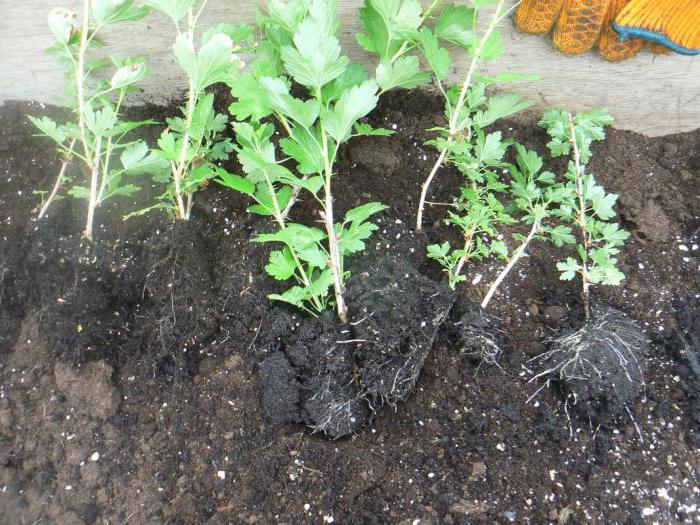

Most often, this method is good for breeding American varieties. The workpieces are made in October or even November. Choose annual shoots and cut off the tops with a length of 25 cm. They must be completely healthy, without any signs of malaise. All leaves should be completely trimmed and the sections treated with paraffin wax. This cutting is stored in the refrigerator or buried in the snow. As soon as spring comes, such blanks are buried to a depth of fifteen centimeters. If you plant several copies, then the distance between them should be at least twenty centimeters. When burying cuttings, it is important to follow one simple but mandatory rule. Two buds should be left above the surface of the soil, updating the cut, and four buds are located underground. The land around is compacted, watered and mulched using peat or humus.
You can also propagate gooseberries using cuttings. This is done as follows. Select the branch that is closest to the ground and make an incision on it. We dig a shallow hole in the soil, bend a branch with an incision to it and fix it using a wire curved in the form of a hairpin for this. Sprinkle it all with earth and water it well. As long as the growing season lasts, this place should be constantly humid. In the fall, roots will appear in this section. The next year, as soon as spring comes, the rooted seedling must be separated from the mother bush using a sharp pruner. Now all that remains is to transplant the young bush where it should grow constantly.
Currant after harvest
Fruiting of currants begins in mid-July and lasts 20-30 days. Most often, black and red currants are grown, although in recent years, white currants have also become widespread. The difference between these species is not only in the color of the berries, but also in the fact that the leaves of black currant are much more fragrant than the leaves of white and red due to the fact that glands with essential oil are located on them.
Despite the fact that in recent years, blueberries, honeysuckle, wild strawberries and blackberries, as well as the overseas curiosities of actinidia, black and red currants, are increasingly grown in our gardens, along with berries such as gooseberries, raspberries and strawberries , is still one of the most popular berry crops in our climatic region.
Watering currants
Black currant, perhaps more than all berry bushes, is demanding on soil and air moisture. And in nature, it most often grows along the banks of rivers, in humid lowlands with flowing groundwater - currants do not like stagnation of moisture in the roots.
Red currants are less moisture-loving, but they also need regular watering. The lack of water in the first half of the season negatively affects the quality and quantity of the current year's harvest, and the lack of moisture after picking berries has a bad effect on the setting of flower buds and the accumulation of plastic substances for the next year's harvest.
If the fall is dry, give the currants a good winter watering in October. Most of the roots of currants lie at a depth of 40-45 cm, so the soil should be moistened to a depth of 50 cm. The approximate rate of water consumption is 4-5 buckets per m².Watering is carried out along furrows along currant bushes or by sprinkling. The best time is early in the morning or after 4:00 pm.
Feeding currants
In late September or early October, organic and mineral fertilizers are applied under the currant bushes at the rate of 10 kg of compost or rotted manure, 40 g of potassium chloride and 100 g of superphosphate for each bush, followed by abundant watering and embedding of fertilizers into the ground by digging. Fertilization of currants with nitrogen-containing preparations after harvesting is not carried out. Instead of the listed funds, you can add a garden or fruit and berry mixture.
Currant pruning
Currant care involves sanitary and formative pruning of bushes. Of all the berry bushes, black currant needs to be pruned the most, and the first shearing of the bush is carried out immediately after planting, so that it is easier to form it during subsequent growth. The formation of a growing bush continues for the next 2-3 years, until the seedling turns into a full-fledged bush by the fourth year of life.
A well-formed bush should have from 10 to 15 branches of different ages, and there should be two to three more annual branches than five to six years old. Branches over six years old become unproductive and should be removed. The best time to prune currants would be early spring, but currant buds wake up too early and pruning time is easy to miss.
In addition to removing unnecessary shoots and branches after harvesting, it is advisable to remove all leaves from blackcurrant bushes, since insect pests often settle in them, and pathogens of fungal diseases are easier to infect the leaves. You need to put on a glove on your hand, gently grab the shoot or branch at the base and run your hand from the bottom to the top.
Leaves that could not be torn off, carefully cut off with scissors or secateurs. Do not run your hand backwards along the shoot - you can damage or rip off the buds. After that, scoop up the foliage and burn it or dig it up on the ground. Red currant also hibernates without leaves, but you cannot pick them off - the leaves must fall off themselves.
In autumn, from mid-September to mid-October, currant propagation is carried out with lignified cuttings. Cuttings are cut from well-developed annual shoots, and it is desirable to cut off the shoots so that there are no stumps left. The top of the bush for grafting is not useful. For cutting cuttings, it is better to use a sharp knife, since the pruner deforms the wood, which sharply reduces the survival of the cutting.
The soil for currants must be prepared in advance - well-decomposed peat mixed with sand in equal parts. The cuttings are planted at a 45 ° slope at a distance of 10-15 cm from each other, the gap between the rows is 30 cm. At least two buds should remain on each cuttings above the ground.
If you dug in layers in the spring, it's time to separate them from the mother bush and plant them separately.
Currant processing
Growing currants involves protecting bushes from such negative phenomena as diseases and pests of currants. Immediately after picking the berries, treat the bushes with actellik in accordance with the manufacturer's recommendations - this will protect the currants from the appearance of aphids or other harmful insects on it. After the autumn pruning and removal of fallen and torn leaves from the site, the currants are treated for the winter with a 1% solution of Bordeaux liquid or karbofos in case pests or pathogens have settled in its bark or in the soil under the bushes.
Gooseberry without thorns
Gooseberry varieties that are partially or completely devoid of thorns are becoming more and more popular among gardeners.


What is the difference between a gooseberry without thorns? Planting and caring for such plants have their own characteristics. These varieties love fertile soils that contain a large amount of humus.After planting, the bushes are cut in such a way that two to four buds remain above the ground on each shoot. The fruits ripen in the second year, and their number reaches one and a half kilograms of berries from one bush. Reproduction takes place by cuttings.
Thornless gooseberries, planting and caring for which require a lot of attention, needs timely complementary feeding. In the spring (from late March to mid-April, as well as from late May to early June), ammonium nitrate or urea is added to the soil. In autumn, in the first half, organic fertilizers are used. And three years after planting, potassium salt and superphosphate are added to the soil annually in autumn. In hot weather, mandatory watering is required.
Self-fertility of this variety is low. Experienced gardeners recommend planting several bushes at a distance of one meter from each other for pollination.
It is also necessary to periodically spray the plants to prevent the invasion of pests and to avoid damage by powdery mildew. Twice a season they are sprayed with "Karatan" or "Topaz". And during the period when leaves are blooming - with one of the insecticides, for example, "Novaktion".
Rules and features of pruning bushes
The gooseberry is a berry bush, so it grows quickly, shades itself, gets sick more often and bears worse fruit. In order to prevent such consequences, it is recommended to carry out autumn pruning, since it contributes to:
- improving the flow of sunlight and air to the branches located inside the bush;
- reducing the risk of developing diseases and damage by harmful insects;
- giving the shrub the correct shape, so it will be easier to care for the plant.
Meanwhile, it should be understood that incorrect and untimely pruning will make the shrub weak and worsen its yield. So that after picking berries, it is worth determining the optimal timing and rules for this garden manipulation.
When to prune?
It is necessary to focus on pruning shrubs in November, and this procedure is carried out in two periods:
- After harvest... A sanitary pruning is carried out, in which dried and diseased branches are eliminated.
- After leafy abscission... The rejuvenating and formative pruning option is carried out after leaf fall, but before the cold weather comes, and a minus temperature is established.
Autumn pruning is about leaving 5 strong shoots evenly spaced against each other. They should bring the harvest next year.
What to trim?
You need to trim:
- all branches affected by any ailment, dried up and with visible damage;
- branches with a very low location (other shoots cast a shadow on them, they lack food and solar heat, therefore they do not give a good harvest);
- branches with excessive thickening of the crown (they grow in the center or inside the plant itself and begin to get tangled with other branches);
- all old branches (five years of age and older).
A young and feeble growth with thin branches is shortened to the largest bud. It should not go to the inside of the bush, but to the outside.
There are also so-called "zero" shoots growing from the ground. If they are strong, then they should be shortened by a quarter above the buds for optimal branching. Weak shoots must be completely cut out in order to prevent shading of the crown. The number of shoots should not be more than four.
Correct pruning technique
It is best to prune old gooseberry bush with a lopper or a sector that has long handles. Of course, you can also use a regular pruner, which is designed for pruning young branches, but when working with it, you can prick yourself, since the bush is prickly. To protect your hands, wear protective gloves, such as a welder.
The sector must cut all the lower and old branches, as well as replacement shoots, to the base. Excess growths and competing branches should also be eliminated without stumps, in the immediate vicinity of the branch site. It turns out that the pruning of an old branch goes to the point where it branches or there is a young growth.
In order to shorten the fragile young shoots more successfully, it is important to find a strong bud on the outside and trim it above it with a centimeter indent.
Young shoots differ from old ones in that they are thinner and lighter in color. So, old shoots are quite thick and have a dark brown tint, close to black. Consequently, as the gooseberry ages, the branches become thicker and darker.
Tips and tricks for pruning gooseberries, the blogger shares in the video below:
The scheme of the formation of culture by years
To get strong bushes and good yields, it is advisable to follow a clear pruning scheme over the years:
- immediately after planting seedlings - all shoots are shortened, leaving 3-4 buds above the soil surface;
- after 1 year - all shoots are pruned into 4-5 buds, leaving several zero shoots (during the same period, sanitization begins - diseased branches and those that are directed to the center of the bush are removed);
- after 2 years - pinching of zero shoots (by 1/4) is carried out, as well as shortening the growth on skeletal branches;
- in 3-4 years - they will do all the same manipulations as in the previous period, not forgetting about sanitary pruning;
- for the 5th year and beyond - carry out sanitary pruning, and then rejuvenating, completing the process with manipulations of the type of 2 years.
Every year, be sure to leave 2-3 new zero replacement shoots.
Formation of the trunk
The standard method of forming a bush is also used, which makes caring for it easier. The method consists in the formation of a round shrub with branches of different ages. It is important to determine the height of the stem. The meter is considered standard, therefore, the side shoots are leveled to this mark.
A soft tube is put on the trunk to prevent the passage of light, a little more than a meter long, and the bush is tied to a support for the fortress. Further, strong young branches are shortened, about half the length, and old ones (from 7 years old) are removed completely.
This method significantly saves space on the site and allows good lighting. But for this type of pruning, only frost-resistant gooseberry varieties should be chosen, because a tall bush is less resistant to cold weather.
Gooseberry diseases
Powdery mildew is considered one of the most dangerous gooseberry diseases. Its other name is spherotek. This disease can destroy the entire crop overnight.
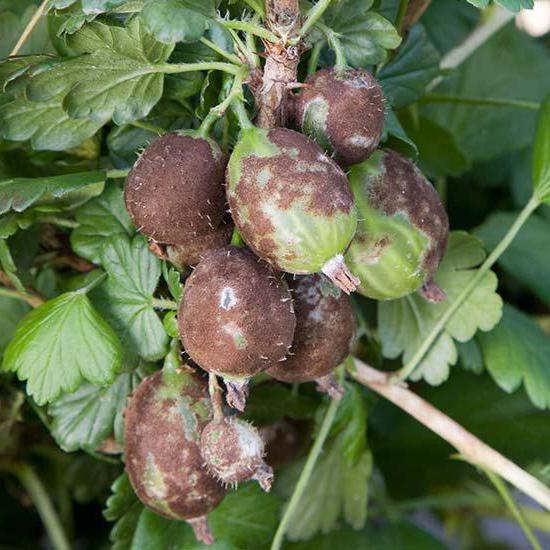

And if the disease is not treated, then in a few years the end of the whole plant will come. The most dangerous time in this respect is when the weather is warm and humid. The gooseberry is covered with a loose bloom of white color, which appears on the leaves, shoots and set fruits. Later, this plaque transforms into a crust that has a brown tint. The shoots under it bend and dry out, the leaves break, and the fruits do not ripen and crumble to the ground. To prevent the disease with powdery mildew, it is necessary to treat the gooseberries before they bloom with a solution of a preparation containing HOM copper. Forty grams of the drug is used for ten liters of water.
Of the other ailments of gooseberry, the most common are anthracosis, mosaic and goblet rust.
Mosaic refers to diseases of a viral nature. It is impossible to rid the plant of it. If the affected bushes were noticed, then they should be immediately dug up and put on fire. The rest can be healed. For this, the plant is treated with "Nitrafen" or copper sulfate. Spraying is carried out two times: first, before bud break, and then ten days after the harvest is harvested.To prevent such diseases, it is necessary in the spring to remove all last year's leaves from under the bushes, and also to prevent weeds from appearing in the garden.
We examined how to maintain a healthy gooseberry (planting and care), diseases, as well as ways to prevent them. Now let's talk about pests.
Of the pests, the most common are the shoot aphid and the gooseberry moth. The moth lays eggs in flowers. Caterpillars emerging from eggs eat fruits in all directions. And the shoot aphid, as a result of its vital activity, leads to curling of leaves and curvature of the shoots. The berries are crushed and fall off.
Of course, pests can be controlled using various insecticides. But it is better to carry out preventive measures. Immediately after the snow melts, cover the soil under the bushes with dense material. Sprinkle the edges of the canvas with earth. Then the moths will not be able to crawl out of the ground. After the gooseberry has faded, the material can be removed. Hilling of bushes should be carried out in autumn.
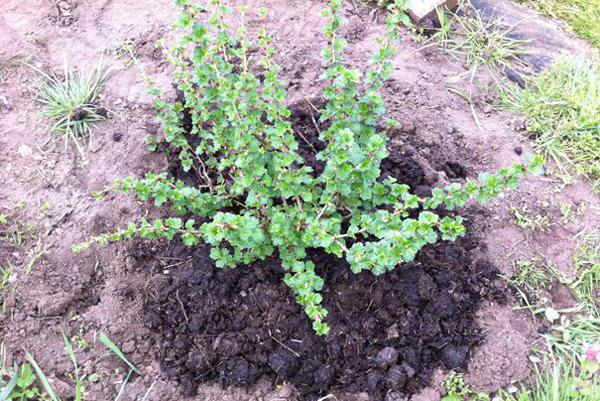

Do this to a height of about ten centimeters. If you notice fallen berries, and even with caterpillars, then it is better to pick them right away. When the plant has faded, treat it with Lepidocide or another similar agent.
In this article, the gooseberry plant, which is so popular in our gardens, was considered, planting and caring for it, as well as methods of reproduction and prevention of its diseases. Having studied all the simple rules for growing this crop and consistently applying them in practice, you will get beautiful healthy bushes that bring a bountiful harvest of delicious berries for many years. And also in winter you will delight yourself, your friends and loved ones with aromatic gooseberry jam.
Cleaning and digging the gooseberry bite zone
After harvesting the fruits, you must immediately remove fallen leaves from under the bushes, spoiled and crushed berries, dry broken off twigs, as well as other plant residues. Then you should carefully weed out the weeds and loosen the top layer of the earth to a depth of 2-3 cm.
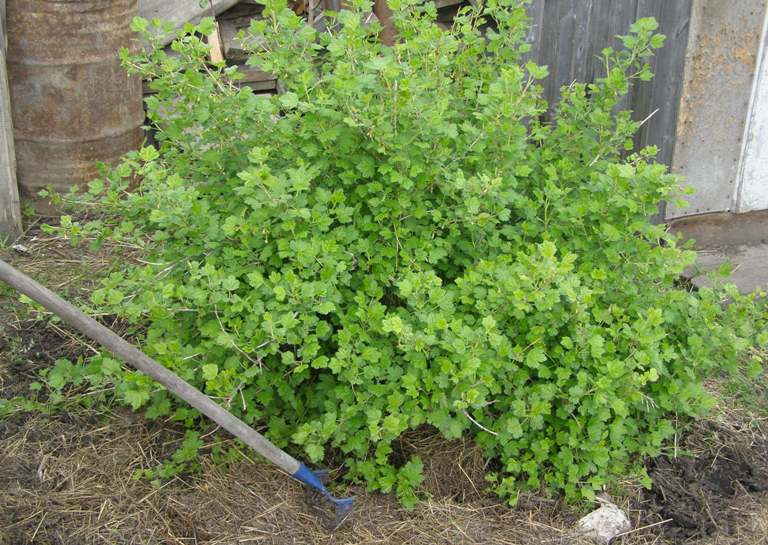

At the end of the fruiting of the gooseberry, it is necessary to immediately remove all plant residues in the bite zone and loosen the ground
Protection from pests and diseases
If signs are revealed that indicate the presence of diseases or damage to the shrub by pests, special treatment is carried out. The same actions are carried out for preventive purposes. Only if there is a problem, they are performed twice, if not, a single procedure is sufficient.
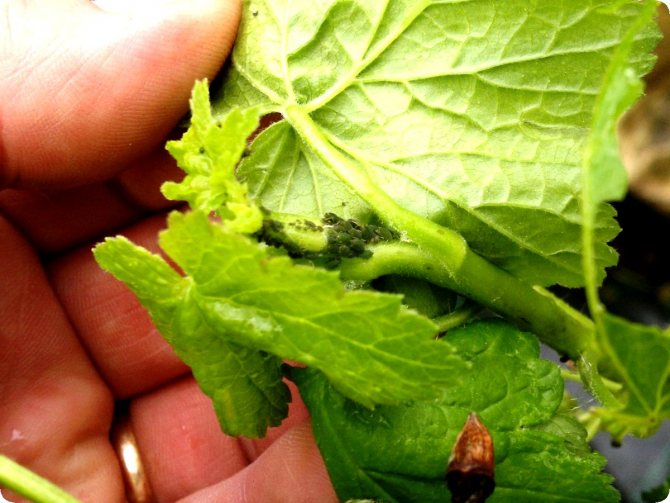

To protect the plant from fungal infections, it is useful to carry out processing:
- bordeaux liquid;
- Topaz;
- copper chloride;
- Fundazole.
What parasites are troublesome
Alas, most fruit crops have low resistance to insect pests. And gooseberries are no exception. But the greatest harm is caused by the gooseberry moth and the shoot aphid. Therefore, we will tell you about them.
Moth butterflies appear shortly before the gooseberry bloom and lay their eggs directly in the flowers. After a few days, caterpillars of a bright green color appear, which destroy the fruits, gnawing them to get to the seeds.
With aphids, everything is simple: they eat greens and cover the leaves with sweet, sticky milk, which causes the leaves to curl, the shoots become thinner, and the berries fall off.
Any insecticide sold in garden stores will work for both pests. Fufanon and Aktellik have proven themselves very well.
Transfer
You can plant and transplant gooseberries both in spring and autumn. But in the autumn months, this procedure is better to carry out, since the ground is soft and it is easier to dig a planting hole. In addition, in spring, the aboveground part of the plant has a higher growth rate than the root system. Therefore, after the spring planting, the bush may well die.
In autumn, it is possible to plant seedlings in the ground from the second half of September in regions characterized by a harsh climate.In October, this procedure will be successful when planting in black soil. The nutrient medium and the optimal planting time will enable the plant to quickly adapt to new living conditions.
The transplant is well done in the fall months. At this time, the planting of the shoots obtained from the layers is usually performed.
Planting should be done in a well-lit area that is protected from the cold north wind. You can also choose elevated places where there is no stagnation of water in the spring.
Gooseberries should be planted 1.5 m away from other plants or buildings. Leave 2 m of free space between adjacent bushes.
Before planting a bush, dolomite flour or lime must be added to the soil. In an acidic environment, peat or sand is added to the soil. This will give you a healthy and strong gooseberry. Caring for this berry crop in the fall involves the introduction of fertilizing.
Useful properties and contraindications
The chemical composition of gooseberries is very diverse. It includes many components that are beneficial to human health.
Among them:
- vitamins of group B, A, E, C. K, P;
- fructose, glucose;
- organic acids (oxalic, malic, citric);
- pectins;
- flavonoids;
- tannins;
- mineral components (potassium, iron, cobalt, iodine, zinc, copper, phosphorus).
Attention! The calorie content of 100 g of gooseberry is 45 Kcal, so it is indispensable for losing weight.
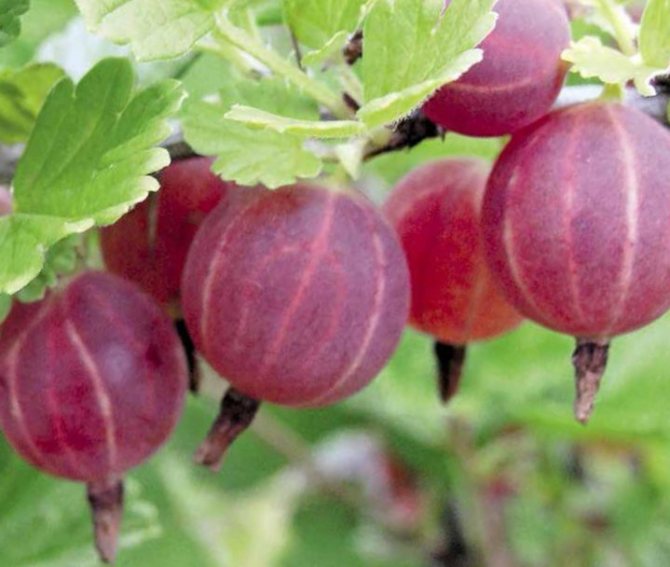

Has beneficial properties
The main useful properties of the product:
- improves memory, attention, prevents the development of sclerosis;
- prevents the formation of tumors;
- lowers blood pressure;
- normalizes hormonal balance;
- increases appetite;
- improves blood circulation;
- increases hemoglobin;
- has a diuretic effect, and thereby improves the functionality of the kidneys;
- normalizes the work of the digestive system, eliminates constipation;
- helps to strengthen teeth and gums;
- promotes rapid recovery after physical exertion;
- energizes and energizes;
- reduces the level of bad cholesterol in the blood;
- improves metabolic processes.
On a note! The berries also contain the hormone of happiness - serotonin, so it helps fight bad mood and depression.
Gooseberries come in different varieties, which differ in fruit color, ripening time and taste. But at the same time, the beneficial properties of the product are fully present in each form. Varieties with dark berries ripen much earlier, their taste is sweeter, but they cannot be stored for more than 2 days. Green fruits are high in vitamin C, they are more acidic and therefore are recommended for processing.
In some cases, gooseberries can be harmful to the body. It should not be used by people suffering from acute diseases of the digestive system, as well as stomach and duodenal ulcers. In addition, it should be given with caution to children under 3 years of age.
Varieties found in modern gardens
The oldest varieties that have come down to us were bred in the middle of the last century. About 50 varieties are included in the State Register. Each is adapted to certain climatic conditions, has its own advantages and disadvantages.
Russian
This is one of the oldest varieties; it was entered in the State Register in 1959 for all regions, except for the Urals. The bush has strong growth. In the 50s, they already knew how to breed varieties that are resistant to powdery mildew, Russian is one of them. In addition, in winter this gooseberry tolerates temperature extremes; in summer, it regularly produces good yields without any pollinators - up to 10 kg per bush. The berries are large, each weighing 4–6 g, in full ripeness it turns dark red. The taste is sweet and sour, very pleasant. From the gooseberry of the Russkiy variety, desserts and winter preparations of high quality are obtained.


Berries of the Russian variety are large, red, with pink veins
Russian yellow
The clone of the Russkiy variety entered the variety testing in 1964. It is more winter-hardy, therefore it is recommended for growing in the North-West and Ural regions. The bush can get sick with powdery mildew, but with good care it is more productive. The berries are large - 5–7 g, in technical ripeness they are green, when ripening, they turn golden. The pulp is also tasty and more tender than that of the Russian. When grown on an industrial scale, up to 140 centners are harvested from one hectare.
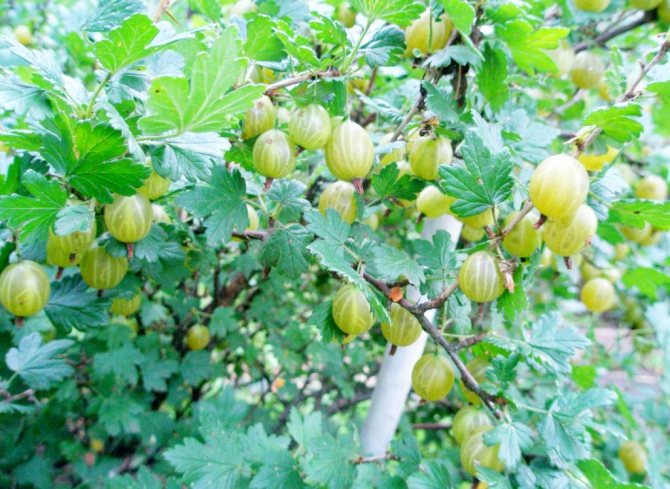

Russian yellow is one of the most productive varieties. Branches are strewn with golden berries
Ural grapes
Early gooseberry, zoned for the Middle Volga. The bush resembles grapes only with large and carved leaves. Otherwise, this is an ordinary gooseberry with small (2.4 g) green berries. The yield is almost 10 times lower than that of the Russian yellow - 16 c / ha. However, the Ural grapes are famous for other benefits - a refreshing aroma of berries, a high content of vitamin C in them, winter hardiness of shoots and excellent resistance to diseases and pests.
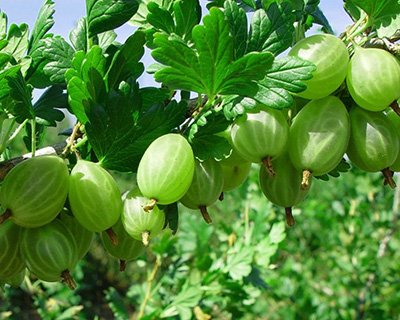

The Ural grape variety has large and beautiful leaves, and the berries are small, but fragrant and tasty.
Northerner
The variety was created for the West Siberian and Middle Volga regions. Its powerful shoots are not afraid of frost and do not get sick with powdery mildew. The berries are green and yellow, large (up to 8 g), but they are not as abundant on the branches as in the varieties Russian and Russian yellow, so the yield is much lower - 60 c / ha. On the other hand, the berries are very tasty, they received the highest score from the expert tasters - 5 points. The fragrance is unfortunately missing.


The northerner is inferior to many varieties in the abundance of berries, but the fruits are large, with an excellent taste
Kubanets
Bred at the end of the last century for the South of Russia. If all the previous varieties are vigorous, but compact, then this one, on the contrary, is low and spreading. As befits a southern gooseberry, the Kubanets bush has thick shoots, large leaves and sweet berries with an average weight of 5.6 g. The yield is impressive - up to 160 c / ha, but the tasting score is low - 4.4 points.
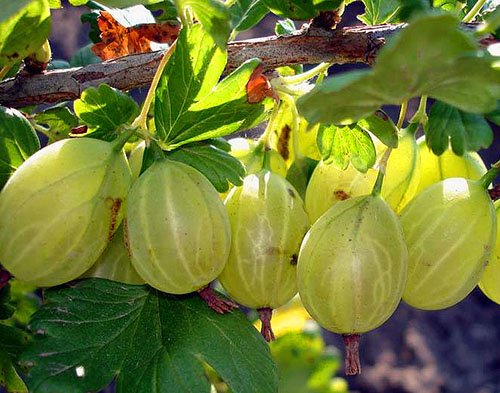

A characteristic feature of the Kubanets variety is a long stalk
Chernomor
The variety was created specifically for the Moscow region. It is obtained by mixing pollen of four varieties: Date, Brazilian, Green Bottle and Maurera Seedling. The result is a vigorous gooseberry with sweet berries that are almost black in full ripeness. We managed to combine the exotic look with high resistance to frost, American powdery mildew, fire flames. Small berries - up to 3 g, but the shoots are covered with them, so the yield is high - up to 148 c / ha. The taste is estimated at 4.3 points.
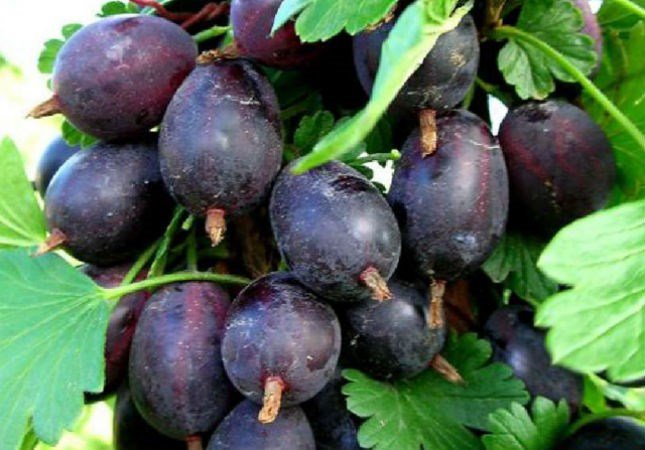

Chernomor berries in full ripeness are almost black, covered with a whitish wax coating
People's
Contrary to the name, the variety was bred not for all people, but only for those living in Western Siberia. It was in this region that it became widespread, which is not surprising - the variety is not afraid of frost, drought and heat, it is resistant to pests and diseases. The berries are dark red, medium-sized (3.2 g), but with a very good dessert taste. The tasting score is 4.8, but the yield is low - no more than 48 c / ha.


The folk one is covered with red berries that hang on long stalks, therefore it is better known under a different name - Elegant
Botanical description and characteristics of culture
Gooseberry is a shrub that grows up to 120 cm high. Outwardly it looks like a currant. The bark is dark gray or deep brown. Over time, it peels off the branches. All branches have large thorns that cause discomfort when harvesting. The characteristic of the shoots indicates a cylindrical shape. The shade is gray.


The leaf plate consists of 3 teeth. The shade of the foliage is rich green. The kidneys are brown. Their surface is covered with scales of a red hue. The buds are located in the axils of the thorns.
Gooseberry flowers are either green or red. They are bisexual, so the culture has self-pollination characteristics. Based on the description, the fruits are oval or spherical. Coarse bristles are found on the surface of the peel. Ripe fruits come in a variety of shades, from green to yellow or purple.
Did you know? Some traditional medicine experts recommend consuming fresh gooseberries to cleanse the body of radiation. Also, the fruits belong to dietary products, since 100 g of the product contains only 44 kcal.
How to buy gooseberry seedlings correctly
The quality of the planting material is very important. Gooseberry seedlings must be healthy, free from quarantine diseases and pests. Otherwise, it will be impossible to achieve generous fruiting. That is why it is best to buy seedlings from specialized nurseries or from reliable sellers.
Since most gooseberry varieties do not propagate well by cuttings, cuttings are most often offered. A quality seedling is considered to be a layer with one or more shoots at least 5 mm thick and 2-3 skeletal roots at least 15 cm long. When buying a seedling, make sure that it is alive. To do this, make a transverse cut of the root. If it is white or cream - the root is alive, and if it is gray, brown or black - it means that it has already died, you should not take such a gooseberry seedling.
Then you need to check if the kidneys are alive. To do this, the kidney is separated, kneaded with your fingers, it must be moist. It is also worth picking up the bark if a moist green layer underneath is a good sign. You can buy a seedling only if you are convinced that it is viable.
How to prune?
We prune gooseberry bushes in order to give the plants the correct shape. In addition, competent pruning will save the bush from thickening and will contribute to a bountiful harvest. You may be surprised, but even a newly purchased bush, consisting of only 3-4 branches, should be pruned! On each of them, you need to leave 2-4 kidneys, and the rest can be safely removed. Do not worry, next year the bush will grow rapidly and may already give its first harvest!
In the spring of next year, as soon as branches from the roots begin to grow from the ground, we leave 3-4 pieces of them, and remove the rest. We choose only powerful, well-developed shoots. Their tops will need to be cut off so that side branches appear. However, in varieties with a high degree of branching, this procedure need not be done: everything will work out by itself. Remember that the degree of shortening of the shoots must correspond to the degree of their development. As a general rule of thumb, the more branching, the more moderate pruning.
If you stick a branch into the drainage hole of the pot in the spring, then by the fall you will have a new plant.
Want to get bigger gooseberries? Then in the summer, do additional pruning of green shoots, leaving no more than six leaves and one berry in each brush. This simple technique allows you to get gooseberry fruits much more impressive than usual.
Soil composition
Culture has the ability to adapt well to a variety of soils. Suffers intolerance only to swampy, highly podzolized, acidic and cold lands. This is due to the fact that the roots that are not very deep do not like the presence of excess water and lack of air. Still, the best place for good growth is loose, nutritious, fertile soils. From year to year, if there are sandy, loamy soils on the site, we plant up to 6-8 kg of manure humus, 5-6 kg of peat under a bush.
How to reproduce?
Gooseberries are propagated by bush layering, as well as lignified or green cuttings. It is best to do this in early spring, before sap flow and bud break. I'll tell you how I do horizontal layering. In my garden there is a beautiful old gooseberry called Black Negus. Many of my guests ask me to share this plant with them.So I breed it periodically!
I make an incision on one or several branches close to the ground. I bend the branch to the ground, dig a shallow hole, and lower the branch into it. Then I cover the hole with earth and water it. All summer I keep the soil moist. By autumn, roots are formed in the section of the branch. In the spring of next year, I separate the rooted seedling from the mother bush. The new plant is ready to plant!
Cut the cuttings from root shoots or annual growths of fruiting branches. Each 20 cm long stalk should have at least 4-5 buds.
For rooting of gooseberry cuttings, we are preparing a "school". We dig trenches up to 30 cm deep in the open ground and fill them with coarse river sand. A greenhouse can also be used for a nursery.
Before planting, the cuttings are pre-soaked in water or a solution of a root formation stimulator for a day. Then we plant it obliquely into the nursery, according to the 5 × 10 cm scheme, and so that one kidney remains on the surface.
After planting and watering, we mulch the soil with a small layer of humus (up to 5 cm thick). During the growing season (until the end of August), the seedlings are periodically fed with solutions of mineral fertilizers: for a bucket of water - 40 g of ammonium nitrate, 20 g of superphosphate and potassium salt (sylvinite, kainit).
Gooseberries can give adventitious roots at the bottom, at the base of the branches. Therefore, bushes can be propagated by division.
In the fall, we dig a bush from the ground and divide it into parts that have their own roots and shoots. In this case, we remove the old branches, and shorten the young ones.
Choosing a place for growing
Gooseberries, like many berry crops, picky about the illumination of the site... In shaded areas, it will not work to get a good harvest, the berries become smaller, and their number decreases.
Gooseberries are picky about the illumination of the site
Excess moisture in the soil will also not like gooseberries. In such conditions, there is a high risk of rotting of the root collar of the bush and, as a result, the death of the plant. Therefore, wetlands and areas with high groundwater are best left for other crops. For the same reason, it is worth abandoning the cultivation of gooseberries on heavy clay soils.
Reproduction methods
The most accessible ways of breeding gooseberries are:
- Reproduction by jigs
- Lignified cuttings.
Varieties Donetsk large-fruited, Date lignified cuttings root poorly, therefore, it is more effective to propagate gooseberries of these varieties with green cuttings. They are rooted using a small greenhouse or even under a glass jar.
Cuttings are cut into lengths of 10 - 12 centimeters late May-early June from the growth of the current year and immediately planted in moist soil, leaving 2-3 upper leaves on the shoot. Further care will consist in frequent watering, shading from direct sunlight. Then the covers are removed and the gooseberries are fed with fast-acting fertilizers.
Let's figure out some of the nuances
Where to plant? Gooseberries love good lighting, so you should choose an open area, preferably on the south or southeast side of the site. So that groundwater does not interfere with the development of the root system, their level of occurrence should be at least 1.5 meters.
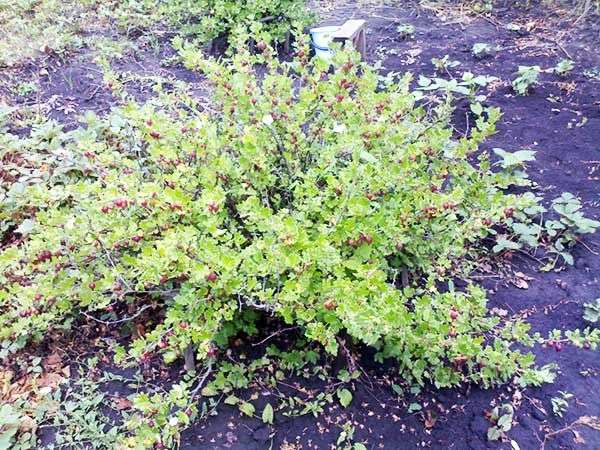

It is preferable to plant gooseberries on light sandy loam soils - the root system in this case grows rapidly, which ensures strong growth of the bush and good yield. Heavy loamy soils do not allow the roots to develop deeper, the plant survives due to the superficial root system. In such soils, the seedling should be rooted, planted at a slope, so that an additional superficial root system is quickly formed.


The planting scheme is as follows: the bushes are arranged in rows, the distance between the planting holes in a row is 1 meter, the distance between the rows is 2 meters. To increase the yield, it is allowed to plant two seedlings in one hole 60 cm wide with an interval of 20 cm between them.This planting pattern provides the plants with an optimal feeding area.
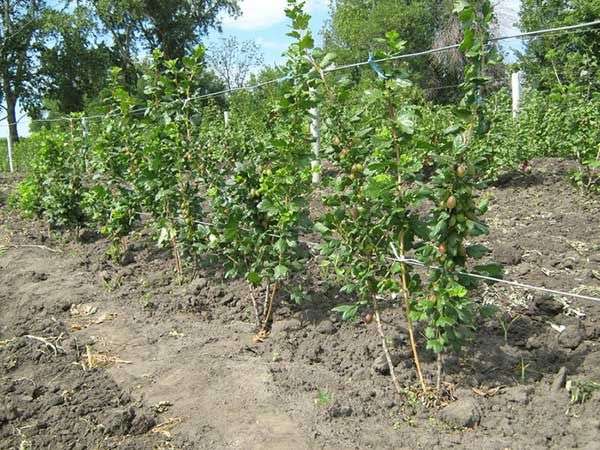

It is important to carefully consider the choice of planting material. Two-year-old bushes with a developed root system should be planted. The length of the roots should be at least 20 cm, while the excessively long roots are shortened to 20 - 25 cm before planting. Examine the shoots - they should not be infected with aphids, spheroteca.


Gooseberry pest control
Here are the pests that gooseberries suffer from:
Gooseberry shoot aphid
These are pests with a body length of 1.5 - 2 cm, light green. They lay black shiny eggs on the branches of the bush at the base of the buds. The appeared larvae feed on the juice of the buds, leaves and petioles of the gooseberry. As a result, the leaves at the ends of the shoots are deformed, the shoots themselves are deformed, and stop growing.
The larvae turn into adult insects with wings, which settle on new bushes. During the summer, several generations of aphids hatch, and the last clutch of eggs hibernates on the bushes, the larvae from it appear next spring.
How to fight
In the spring, the bushes are sprayed on dormant buds with nitrafen (300 g per 10 liters of water). After the appearance of adults, the tops of the shoots are cut off and burned, the plants are sprayed with infusion of tobacco (400-800 g of tobacco per 10 l of water), soap (300 g per 10 l of water).
Acacia false shield
Females of this pest are convex, oval in shape and light brown with red color. The size is 4-6 mm in length, 2-4 mm in width. The larvae are yellow or red-brown in color, have 3 pairs of legs. They stick to the branches of the bush, fix on them, become covered with a semicircular shield and begin to suck the juice out of the branches.
By the beginning of June, adults form from the larvae, which in 20-25 days produce new larvae under the shield. The appeared larvae leave their shelter and begin to suck out the juice from the leaves and petioles of the plant. For the winter, they move to the underside of the branches, firmly attached to them until spring. In spring, when the air temperature rises to 6-7 degrees, the larvae become active, move along the bark, stick to it and the cycle repeats.
How to fight
In the spring, before bud break, gooseberries are sprayed with 2–3% solution of 60% nitrafen paste (concentration 200–300 g per 10 l of water).
When the bushes fade, they are treated with 50% karbofos (concentration 20-30 g per 10 liters of water).
In the fall or early spring, the scale insects are brushed off the bark. With a strong infection, it is impractical to do this, in which case the branches are removed and burned.
Willow shield
Having settled on the bushes, this pest lays eggs in August, which in winter, after its death, remain under the shields. The larvae hatch during the next year's gooseberry flowering. They creep along the shoots, form shields, stick to the bark and suck sap from the branches. The branches look oppressed, dry up.
How to fight
The fight against the willow shield is carried out in the same way as with the acacia false shield.
Currant glass
This pest is a butterfly with narrow transparent wings. Wingspan up to 28 mm. The body is blue-black with yellow rings.
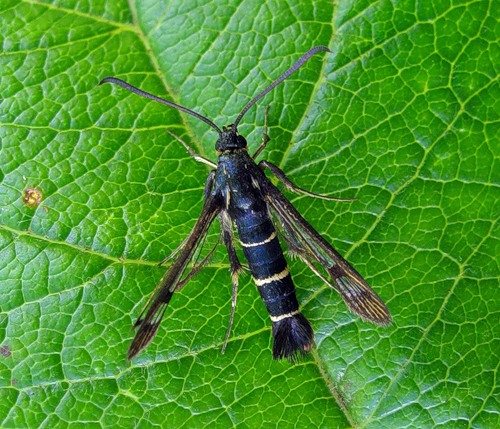

The flight occurs at the end of the gooseberry flowering. Pests lay eggs on the shoots around the buds. And after about 2 weeks, caterpillars appear from the eggs, with a white body and a brown head. Caterpillars are 16-legged. Caterpillars bite into shoots, where they arrange a dwelling for themselves for 2 years. Pupation occurs in the spring after the second wintering. Branches as a result of such lesions dry out.
How to fight
Affected shoots must be removed and burned.
At the end of flowering, after 10-12 days, it is sprayed with 50% karbofos (concentration 20-30 g per 10 l of water).
Green currant gold
It is a green-bronze beetle. Length 6-9 mm. They appear at the end of May and begin to eat the leaves, gnawing small pieces along their edges.7-9 days after emergence, they lay eggs on the branches, from which after 2 weeks larvae emerge, white-yellow, legless, flat, with a wide chest plate, up to 20 mm in length.
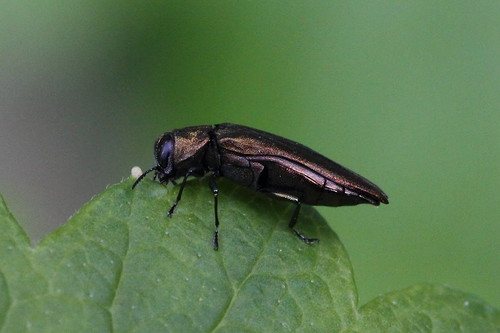

The larvae gnaw passages in the branches and remain inside them for the winter. Damaged shoots dry up, starting from the top, or are strongly inhibited in growth. In March-April, without leaving their shelter, the larvae pupate.
How to fight
Damaged shoots are excised and burned every 2-3 weeks.
Beetles are shaken off the branches onto a film spread under the bush, then they are destroyed. This should be done in the morning, because during the day, especially if it is warm and sunny, the beetles fly actively.
3 weeks after flowering, the plants are sprayed with 50% karbofos (concentration 20-30 g per 10 l of water).
Common spider mite
This pest is especially dangerous in hot dry weather; several generations appear during the season. The mites gather on the underside of the leaves, from which they suck the sap. Because of this, the leaves become at first light and spotty, then brown, and then dry and fall off. In winter, the spider mite does not die, but hides under the fallen leaves.
How to fight
The leaves of the affected plant are cut off and burned, they dig up the soil under the bushes.
During the entire flowering period, from budding to the end, the plants are sprayed with 50% karbofos (concentration 20-30 g per 10 l of water).
With a small lesion, treatment with a decoction of onions, garlic or colloidal sulfur preparations is effective.
Gooseberry moth
This pest is a butterfly. The color is white and yellow, with many large black spots on the wings. Wingspan up to 45 mm Caterpillars have black spots and yellow stripes on their bodies. They move in a loop, the body is pulled up to the head when moving. They spend winter in the soil or under fallen leaves.


After wintering, the caterpillars wake up in early spring and begin to eat the buds, and then the gooseberry leaves. By the end of the gooseberry flowering, the caterpillars turn into pupae that attach to the leaves and branches of plants.
After 3-4 weeks, butterflies fly out, which begin to lay eggs on the underside of the leaves. After 2-3 weeks, caterpillars hatch, they feed on leaves, leaving holes in them. By the end of autumn, the caterpillars grow up and go for the winter.
How to fight
Spraying bushes before and after flowering with 50% karbofos (20-30 g per 10 liters of water).
In autumn and spring, digging of the soil under the plantings is required.
The leaf litter under the bushes is collected and burned.
Since the infection of thickened plantings occurs faster, the bushes must be thinned out.
Gooseberry moth
It is a butterfly up to 30 mm in size with brown spots and stripes on the wings. With the onset of gooseberry flowering, pests lay eggs in the flowers. By the time of the end of flowering, when the berries are tied, green caterpillars with a black head appear. They infect the berries, forming a cobweb around the brushes. Each caterpillar can destroy up to 15 ovaries.
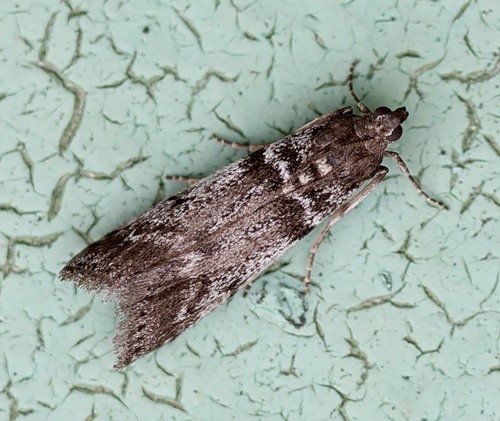

By the end of the season, the caterpillar weaves a cocoon for itself, in which it buries itself in the ground for the winter, to a depth of 3-5 cm. In the spring, a butterfly appears from it.
How to fight
Damaged berries are picked by hand and burned. Before winter, the bushes are spud up to a height of 10 cm. Uncooling is carried out after flowering. Before flowering, gooseberries are sprayed with 50% trichlorometaphos-3 (30 g per 10 l of water), and at the end with 50% karbofos (20 g per 10 l of water).
Folk methods of wrestling are effective. After flowering, when the berries are tied and ripened, a series of spraying with tobacco infusion or wormwood decoction can be carried out (2-3 times in a week).
Where to plant
On the flat or slightly sloping placeswell lit and protected from the winds. Compared to blackcurrant, gooseberry care does not require regular watering. Excess moisture inhibits the development of the plant.
Gooseberries are successfully grown in regions with arid climate... You can plant it on various soils, but a high yield is obtained on loamy, sandy loam and chernozem soils rich in organic compounds.

